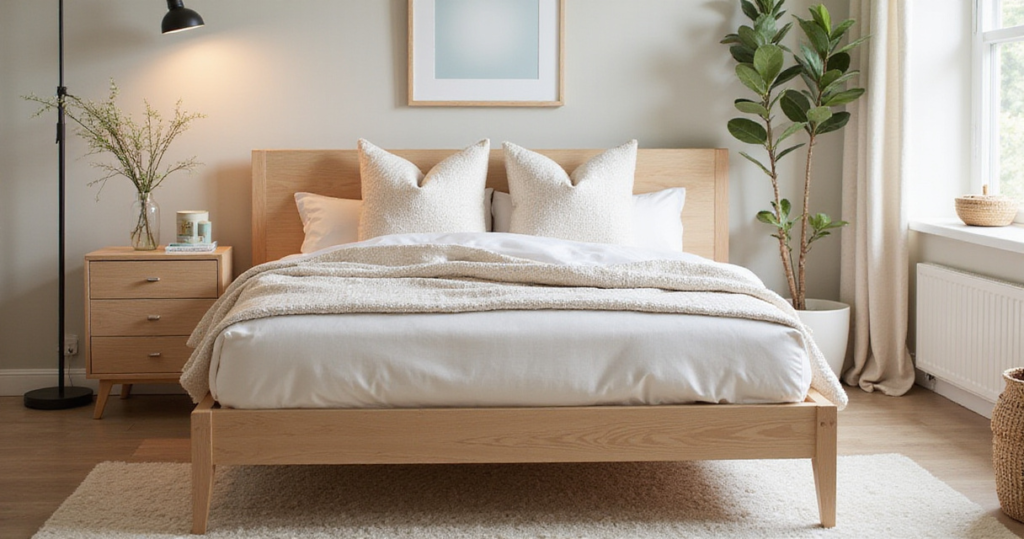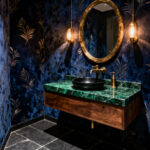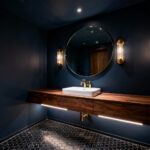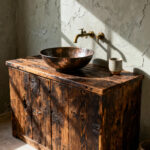Your bedroom serves as more than just a place to rest your head each night—it’s your personal retreat where you begin and end each day, process life’s moments, and recharge your spirit. Yet too often, this vital space becomes an afterthought, a collection of mismatched pieces rather than a thoughtfully curated sanctuary that truly supports your well-being and reflects your unique personality.
The transformation from ordinary sleeping quarters to an extraordinary personal haven lies in understanding how each element of bedroom furniture decor contributes to both function and beauty. From the foundational anchor of your bed frame to the subtle interplay of lighting and texture, every choice creates ripples that affect how you feel, sleep, and live within these four walls. It’s about creating harmony between practicality and aesthetics, ensuring your space doesn’t just look magazine-worthy but actually serves your daily rhythms and deepest need for restoration.
In this comprehensive guide, we’ll explore 20 essential bedroom furniture decor strategies that work together to create spaces that are both stunning and deeply functional. These aren’t just decorating tips—they’re insights drawn from design professionals, sleep experts, and real homeowners who’ve successfully transformed their bedrooms into true sanctuaries. Whether you’re working with a compact city apartment or a spacious master suite, these ideas will help you make thoughtful decisions that enhance both your daily experience and your long-term satisfaction with your most personal space.
1. Select the Perfect Bed Frame as Your Design Foundation
Your bed frame serves as the cornerstone of your bedroom’s entire aesthetic narrative, influencing everything from the room’s perceived scale to its stylistic direction. This single piece of bedroom furniture decor anchors your design scheme while providing the structural foundation for quality sleep. A well-chosen frame can visually expand smaller rooms through strategic design elements like low profiles or open metalwork, while also offering practical benefits like integrated storage that can eliminate the need for additional furniture pieces.
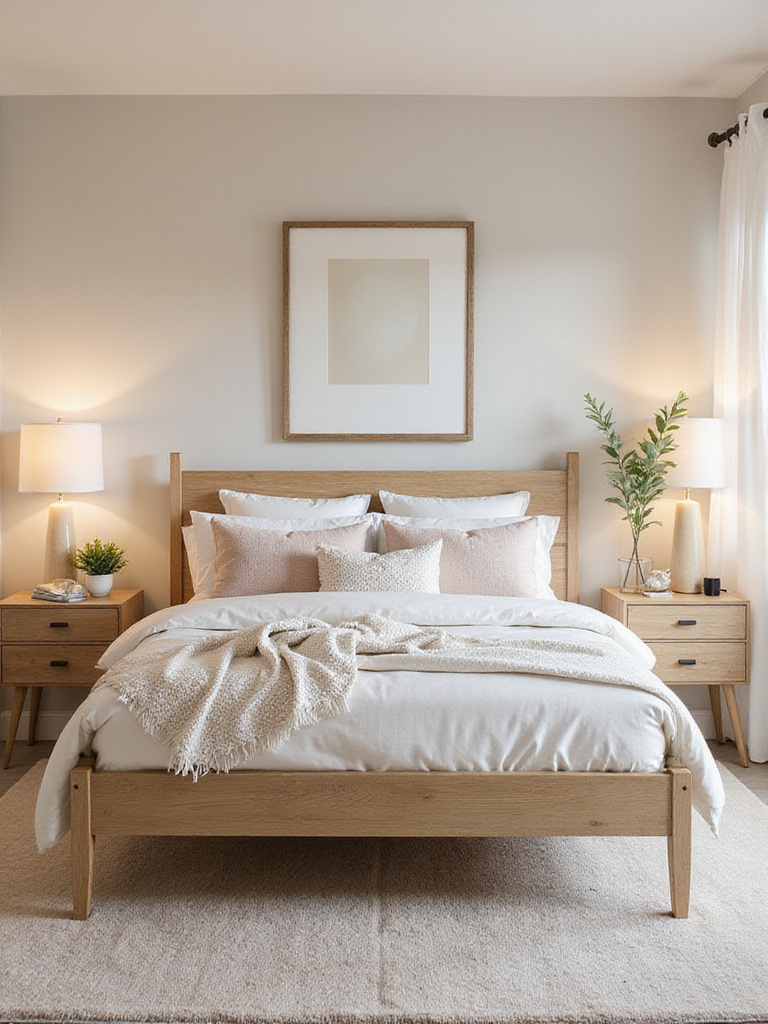
The ripple effects of your bed frame choice extend far beyond aesthetics. Sleep Foundation research indicates that stable, well-constructed frames can extend mattress life by up to 20% while improving sleep quality through better support. For urban dwellers, platform beds with built-in drawers have become game-changers—one couple in a 600-square-foot apartment eliminated their dresser entirely by choosing a storage bed, freeing up precious floor space for a reading nook that transformed their room’s functionality.
When selecting your ideal frame, consider these essential factors:
- Space assessment: Measure not just your room dimensions but also traffic flow patterns around the bed
- Style alignment: Choose materials and lines that reflect your aesthetic vision, from sleek metal for modern spaces to reclaimed wood for rustic charm
- Support compatibility: Verify your mattress type works with the frame’s support system
- Height considerations: Factor in the combined height of frame, mattress, and any box spring for comfortable bed entry
The foundation you choose today will influence every other design decision in your room, making this investment one of the most impactful you’ll make.
2. Create Drama with an Elevated Headboard Statement
The headboard commands attention as the bedroom’s primary focal point, offering an unparalleled opportunity to inject personality and architectural interest into your space. Beyond its practical function of protecting your wall and providing back support, a thoughtfully chosen headboard acts as the room’s largest piece of art, setting the aesthetic tone for everything that follows. Interior designers often recommend investing in custom or uniquely designed headboards because they deliver exceptional visual impact at a fraction of the cost of replacing an entire bed frame.
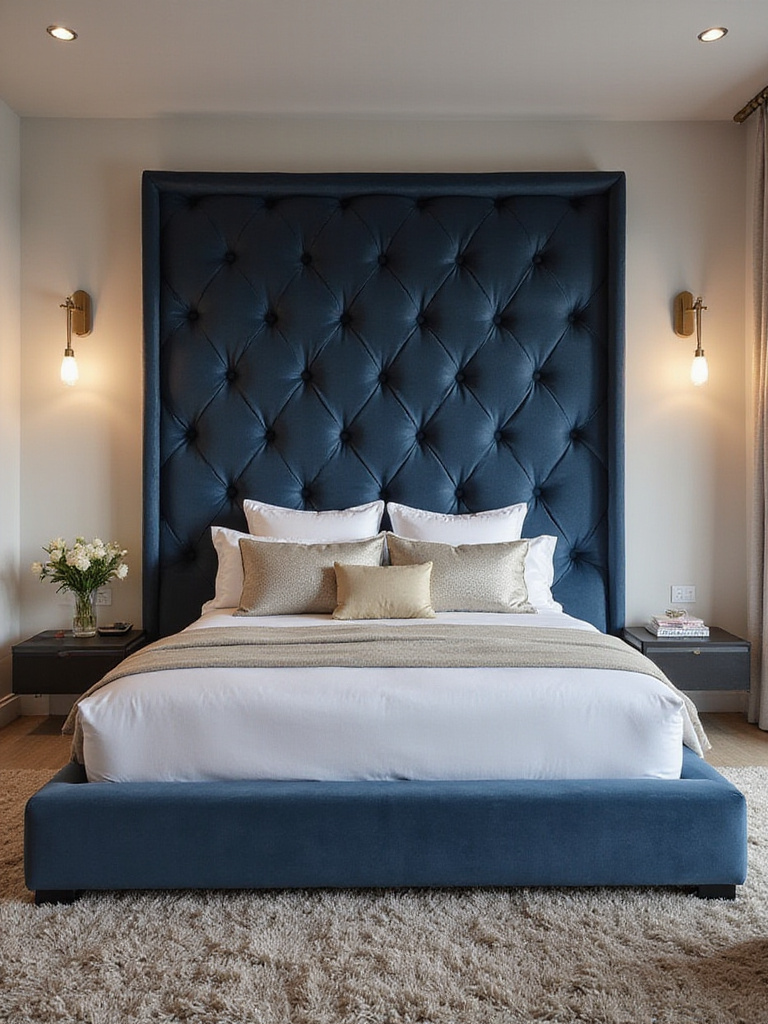
Scale plays a crucial role in headboard selection—going dramatically tall or wide can transform even modest bedrooms into spaces that feel custom-designed and luxurious. One client created the illusion of soaring ceilings in their compact apartment by installing a floor-to-ceiling tufted velvet headboard in deep jewel tones. The verticality and rich texture made their standard 8-foot ceiling feel significantly higher while adding an undeniably sophisticated focal point that elevated the entire room’s perceived value.
Consider these headboard strategies for maximum impact:
- Extend beyond the bed: Choose headboards wider than your mattress to create a more substantial presence
- Embrace texture: Materials like woven rattan, channel-tufted velvet, or reclaimed wood add tactile interest
- Think wall-to-wall: Create an accent wall that serves as a headboard, using wallpaper, wood paneling, or bold paint
What makes this design element truly special is the way it immediately establishes visual hierarchy, drawing the eye and making everything else in the room feel more intentional and curated.
3. Master the Art of Luxurious Bedding Layers
Layering bedding transforms your bed from a simple sleeping surface into a cloud-like retreat that adapts to your comfort needs throughout the seasons. This approach to bedroom furniture decor isn’t just about aesthetics—it’s about creating a sleep system that regulates temperature, provides customizable comfort, and delivers that coveted hotel-luxury feeling every time you slip between the sheets. The National Sleep Foundation notes that 65% of adults struggle with temperature regulation during sleep, making adaptable bedding layers essential for quality rest.
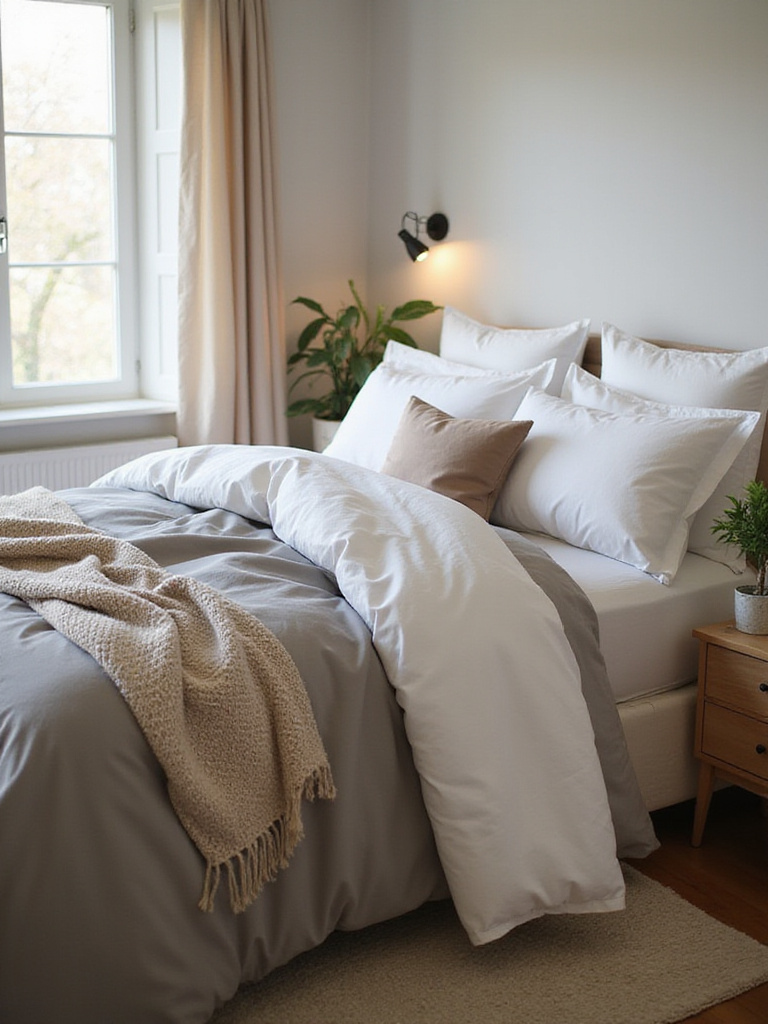
The secret lies in understanding how different materials and weights work together to create both visual depth and functional comfort. Professional stylists follow the “Rule of Three” for pillows—Euro shams for height and structure, standard sleeping pillows with coordinating shams, and carefully chosen accent pillows for color and texture. Each layer serves a purpose while contributing to the overall composition that makes your bed irresistibly inviting.
Here’s how to build your perfect bedding system:
- Foundation layer: Start with breathable, high-quality sheets in materials like long-staple cotton percale or sateen
- Core warmth: Add a duvet with appropriate fill power for your climate, encased in a style-forward cover
- Textural interest: Incorporate a lightweight quilt or coverlet, either spread fully or folded at the foot
- Finishing touches: Layer throws and pillows strategically, mixing textures like chunky knits with smooth linens
The transformation happens not just in how your bed looks, but in how it feels to retreat into this carefully crafted cocoon at the end of each day.
4. Choose Nightstands That Balance Beauty and Function
Nightstands serve as the unsung heroes of bedroom organization, providing that crucial arm’s-reach access to essentials while contributing significantly to your room’s visual balance and style cohesion. These pieces of bedroom furniture decor need to work harder than almost any other furniture in your home, storing everything from books and charging cables to late-night water glasses and morning medications. The key lies in finding pieces that offer adequate storage without overwhelming your space or disrupting the clean lines of your overall design.
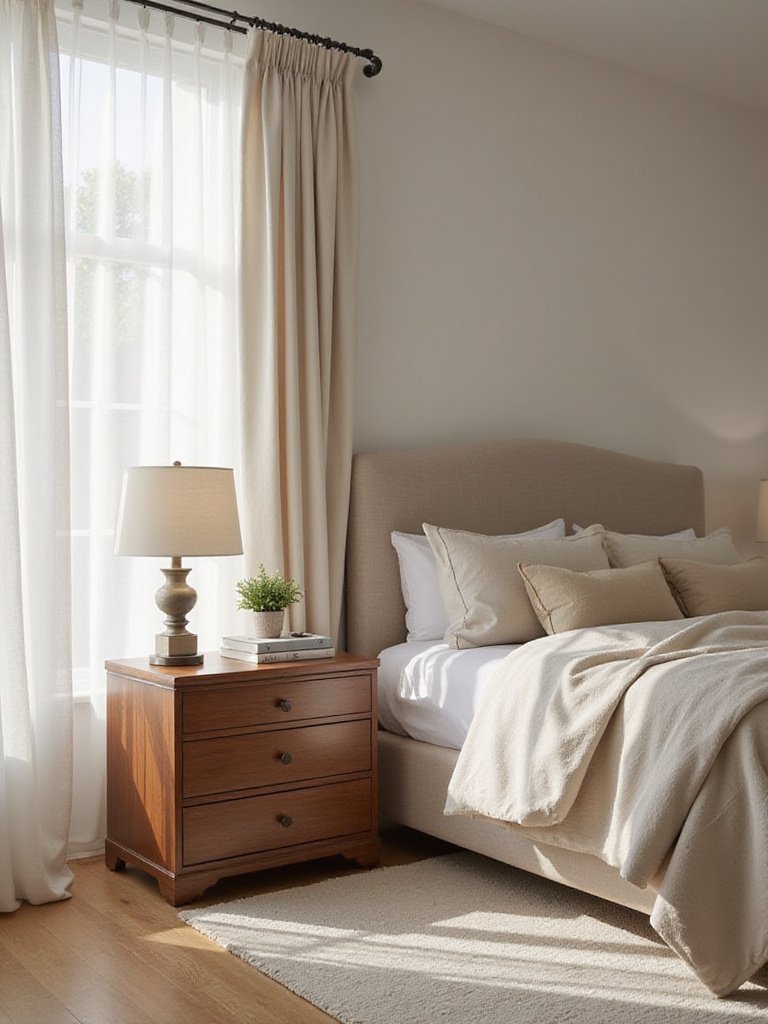
Scale and proportion become critical considerations—your nightstand height should align within a few inches of your mattress top for both ergonomic comfort and visual harmony. Modern solutions have evolved to address our technology-dependent lifestyles, with many incorporating built-in USB ports, wireless charging surfaces, or discrete cable management systems that keep the inevitable tangle of cords hidden from view.
Essential nightstand selection criteria include:
- Height compatibility: Ensure the surface sits level with or slightly below your mattress top
- Storage needs: Choose between drawers for hidden organization or open shelves for display
- Technology integration: Look for built-in charging solutions or plan for discrete cord management
- Style coherence: Select pieces that complement your bed frame and overall room aesthetic
The National Sleep Foundation’s research on sleep environment quality consistently shows that organized, clutter-free bedside areas contribute to better sleep quality and reduced nighttime stress—making your nightstand choice about much more than just convenience.
5. Optimize Dresser Placement for Flow and Function
Strategic dresser placement can make the difference between a bedroom that feels spacious and organized versus one that creates daily frustration through poor traffic flow and wasted space. This substantial piece of bedroom furniture decor requires careful consideration of both its storage function and its impact on room navigation. Interior design expert Sarah Susanka emphasizes the critical importance of maintaining at least three feet of clearance around major furniture pieces, noting that this “walk-around space” is what separates comfortable rooms from those that feel cramped and maze-like.
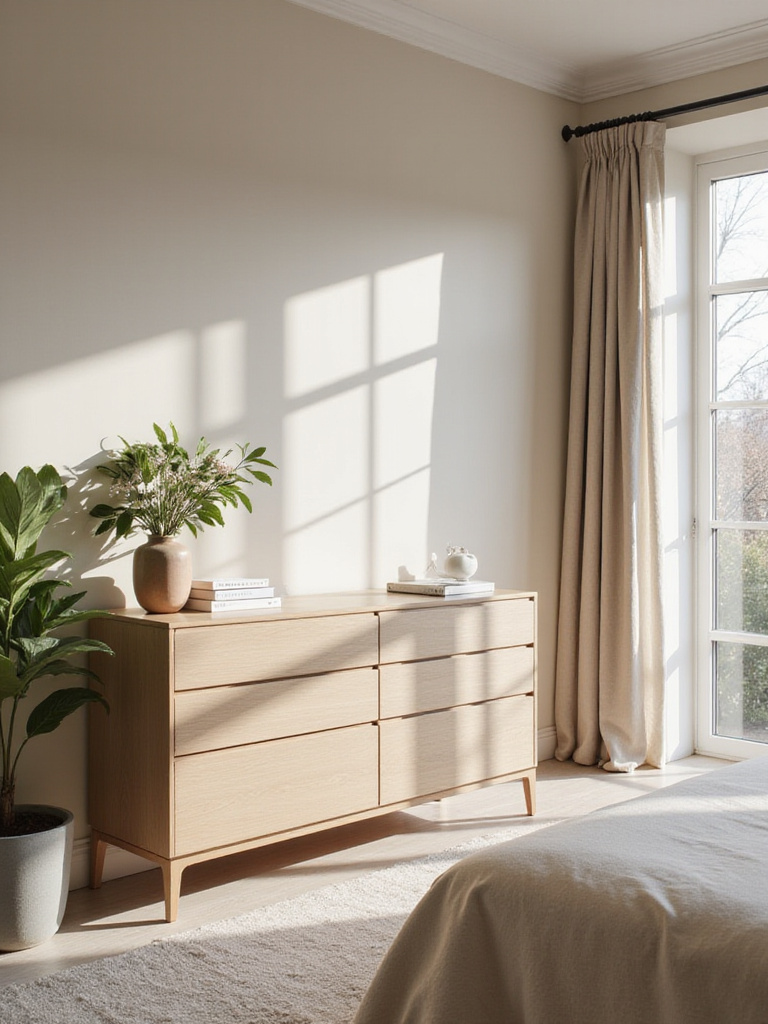
The ripple effects of optimal placement extend beyond mere convenience. When positioned thoughtfully—often along the longest uninterrupted wall or in coordination with closet access—dressers can actually enhance your room’s sense of spaciousness by creating clear sight lines and logical zones. One family solved their bedroom bottleneck by relocating their dresser from directly opposite the bed to an adjacent wall near the closet, creating a clear pathway that improved both safety and daily functionality.
Consider these placement strategies for maximum effectiveness:
- Traffic pattern analysis: Map your daily movement through the room to identify optimal positioning
- Functional grouping: Place dressers near closets or dressing areas for logical workflow
- Visual weight distribution: Balance the dresser’s mass with other large pieces to avoid visual clustering
- Multi-functional opportunities: Position dressers to serve dual purposes, such as supporting a TV or creating a vanity area
The goal is creating a layout where your dresser enhances rather than impedes your daily routines while contributing to the room’s overall sense of order and intentionality.
6. Unlock Hidden Storage Potential Under Your Bed
The space beneath your bed represents one of the most underutilized storage opportunities in your bedroom, capable of housing seasonal clothing, extra linens, and rarely used items while keeping them completely out of sight. Smart under-bed storage solutions can effectively free up 9-12 square feet of closet or floor space—a significant gain in smaller bedrooms or apartments where every square inch counts. Professional organizers consistently rank under-bed storage as a “secret weapon” for decluttering, following Marie Kondo’s principle that every item should have a designated home.
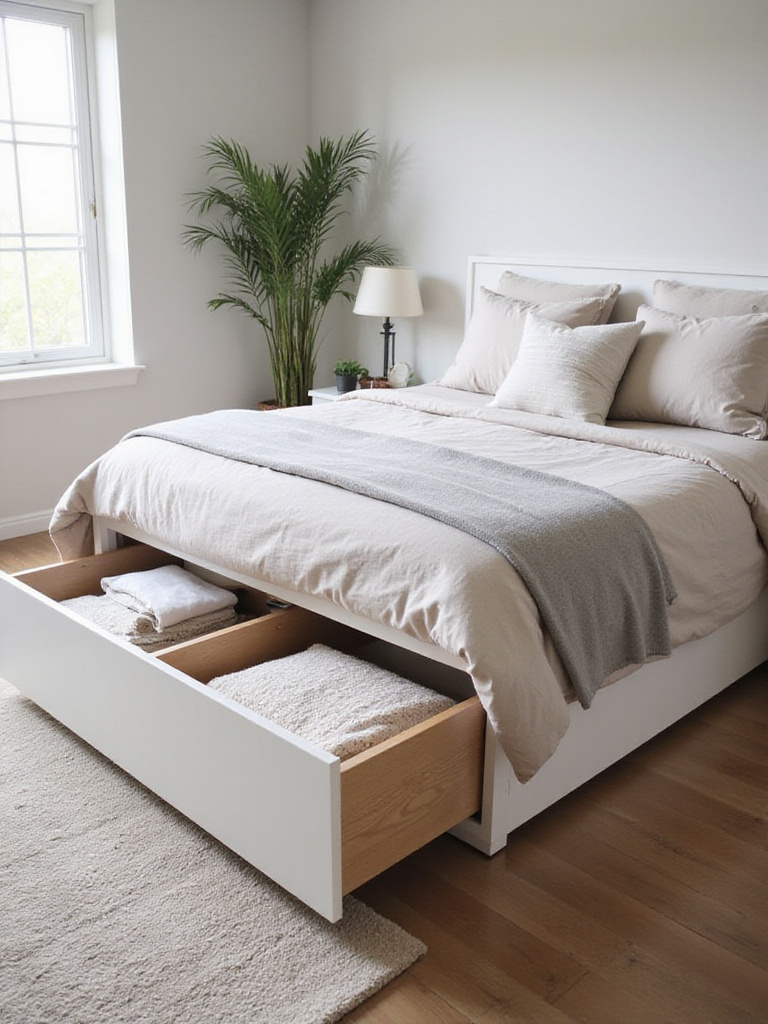
Modern storage solutions have evolved far beyond simple boxes shoved under the bed. Hydraulic lift-up bed frames provide access to the entire under-bed cavity, while rolling drawer systems offer organized compartments for different categories of items. One couple eliminated their monthly storage unit rental (saving $75 monthly) by upgrading to a lift-up storage bed that housed their off-season clothing, camping gear, and holiday decorations—dramatically reducing bedroom clutter while improving their budget.
Effective under-bed storage strategies include:
- Space measurement: Calculate available height and depth to choose appropriately sized solutions
- Item categorization: Group stored items logically (seasonal clothes, guest linens, keepsakes) for easy retrieval
- Protection methods: Use vacuum-seal bags for soft goods to maximize space and prevent dust accumulation
- Access planning: Choose between lift-up beds, rolling drawers, or slide-out bins based on your mobility and usage patterns
The transformation extends beyond mere storage—reducing visible clutter contributes to the calm, serene atmosphere essential for quality sleep and relaxation.
7. Maximize Vertical Space with Elegant Storage Solutions
Wardrobes and armoires represent the ultimate in vertical storage efficiency, transforming wall space into organized havens for clothing and accessories while contributing significantly to your room’s architectural presence. These commanding pieces of bedroom furniture decor can increase usable storage capacity by up to 40% compared to traditional horizontal furniture arrangements, making them invaluable in both compact urban apartments and spacious master suites where organization is paramount.
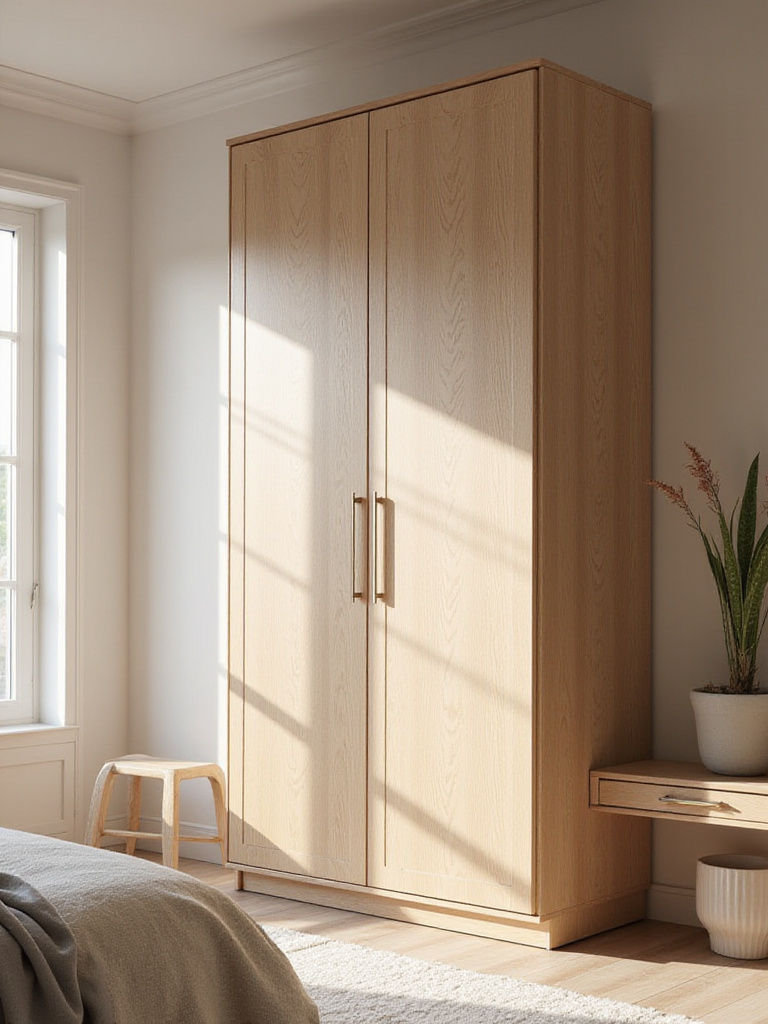
The visual impact of floor-to-ceiling storage extends beyond mere function—these pieces create clean, streamlined aesthetics that make rooms feel larger and more intentional. Interior designers frequently recommend custom built-ins or full-wall wardrobes because they eliminate the visual fragmentation that occurs with multiple smaller pieces. One apartment dweller replaced two dressers and a shoe rack with a single full-wall wardrobe featuring mirrored sliding doors, effectively “gaining” 35 square feet of floor space while creating a brighter, more open atmosphere.
Key considerations for vertical storage success:
- Ceiling height utilization: Extend storage to the ceiling with crown molding or integrated upper compartments
- Internal organization: Plan for a mix of hanging rods, adjustable shelves, and specialized compartments
- Lighting integration: Install LED strips or motion-activated lights for improved visibility
- Door style selection: Choose between hinged, sliding, or bi-fold doors based on room layout and clearance
The National Association of Home Builders reports that 87% of homebuyers prioritize ample bedroom storage, with built-in solutions ranking particularly high—underscoring how these pieces enhance both daily living and long-term property value.
8. Add Sophisticated Seating with Foot-of-Bed Benches
A thoughtfully chosen bench or ottoman at the foot of your bed serves multiple functions while adding a layer of visual sophistication that completes your bedroom’s design narrative. This piece provides practical seating for putting on shoes or laying out tomorrow’s outfit, while also offering potential storage space and serving as a visual anchor that grounds the bed within the room’s overall composition. The key lies in selecting pieces that maintain proper scale—typically between two-thirds and the full width of your bed—to achieve visual balance without overwhelming the space.

Multi-functional benches have become increasingly popular as homeowners seek furniture that works harder in smaller spaces. Storage ottomans can house extra blankets, seasonal accessories, or out-of-season clothing while providing a comfortable surface for daily routines. In compact bedrooms, these pieces effectively maximize utility without sacrificing style, often becoming the difference between a room that feels cramped and one that feels thoughtfully organized.
Strategic bench selection involves several key factors:
- Proportional sizing: Ensure the piece complements rather than competes with your bed’s scale
- Material coordination: Choose upholstery or finishes that harmonize with your existing decor
- Storage assessment: Determine whether hidden storage would benefit your organization needs
- Placement optimization: Position the bench to allow comfortable movement around the bed
The American Society of Interior Designers notes that 68% of clients renovating bedrooms specifically request multi-functional furniture, reflecting a broader trend toward pieces that combine beauty with practical utility in our increasingly space-conscious homes.
9. Create an Intimate Reading Retreat with Accent Chairs
Carving out a dedicated reading nook within your bedroom transforms an underutilized corner into a personal sanctuary for relaxation and reflection. An elegant accent chair serves as the foundation for this intimate space, providing a comfortable alternative to bed-based activities while adding sophisticated style to your room’s overall design. This thoughtful addition to your bedroom furniture decor encourages mindful activities that can reduce screen time and improve evening routines that support better sleep quality.
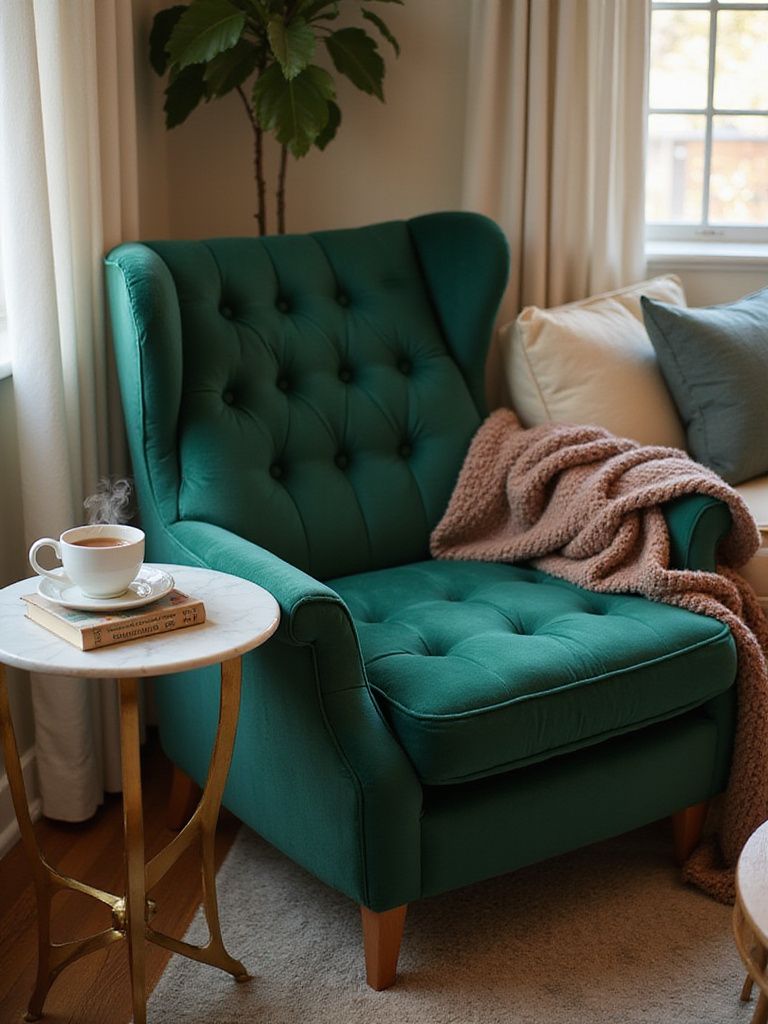
The psychological benefits of having a designated relaxation space extend beyond mere comfort. Sleep Foundation research suggests that engaging in quiet, screen-free activities like reading before bed can improve sleep quality by reducing cortisol levels and promoting natural melatonin production. One client created a reading nook using a rich emerald velvet wingback chair paired with a brass floor lamp and marble side table, reporting a 30-minute increase in daily reading time and significantly improved evening relaxation routines.
Essential elements for your reading retreat include:
- Chair selection: Choose comfortable seating with adequate support for extended reading sessions
- Lighting planning: Incorporate task lighting that reduces eye strain during evening reading
- Surface solutions: Add a small side table for books, beverages, or reading glasses
- Comfort enhancement: Layer in soft textiles like throws and pillows for added coziness
The magic happens when you integrate biophilic elements—a small plant or fresh flowers can enhance the sense of calm while improving air quality and connecting your indoor space to the natural world.
10. Design Sophisticated Lighting Layers for Every Mood
Masterful bedroom lighting combines ambient, task, and accent illumination to create a versatile environment that adapts to your changing needs throughout the day and evening. This layered approach to bedroom furniture decor ensures optimal light for any activity while supporting your body’s natural circadian rhythms through adjustable intensity and color temperature. The ability to control different lighting layers allows you to create distinct “scenes”—from bright morning preparation to focused evening reading to romantic nighttime ambiance.
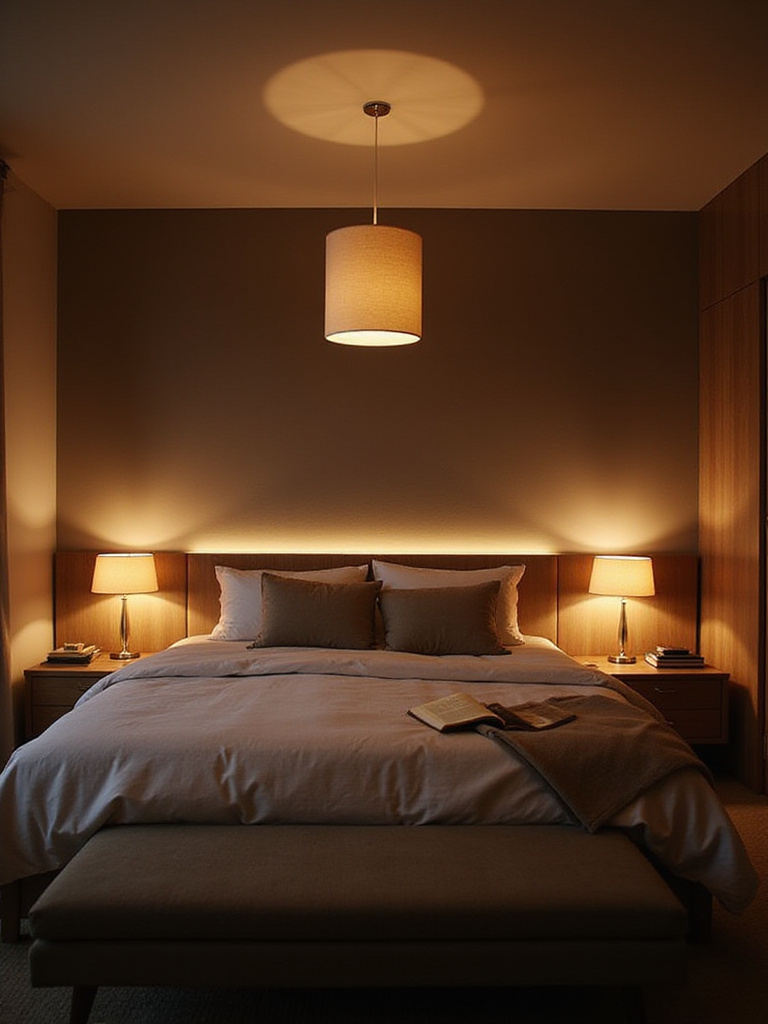
The health implications of proper bedroom lighting extend far beyond aesthetics. Sleep experts emphasize that controlling light exposure, particularly in the evening hours, plays a crucial role in melatonin production and sleep quality. Dimmable fixtures across all layers provide the flexibility to gradually reduce light intensity as bedtime approaches, supporting your body’s natural preparation for rest.
Effective lighting layer strategies include:
- Ambient foundation: Install overhead fixtures on dimmers for general room illumination
- Task-specific lighting: Add bedside lamps, reading lights, or vanity illumination for focused activities
- Accent elements: Incorporate decorative lighting like picture lights, LED strips, or table lamps for visual interest
- Control systems: Ensure all layers have dimming capability for maximum flexibility
The American Lighting Association reports that homes with layered lighting designs show 35% higher satisfaction rates with overall interior ambiance, demonstrating how thoughtful illumination design impacts daily living quality and emotional well-being.
11. Make Bold Statements with Sculptural Lamps
Statement lamps transcend mere illumination to become functional art pieces that define your bedroom’s character and mood. These carefully chosen fixtures serve as jewelry for your room, adding personality, texture, and visual interest while providing essential lighting for daily activities. Interior designer Emily Henderson describes lighting as “the jewelry of a room,” emphasizing how the right lamp can add sparkle and unique character that reflects your personal style while transforming functional necessity into decorative centerpiece.
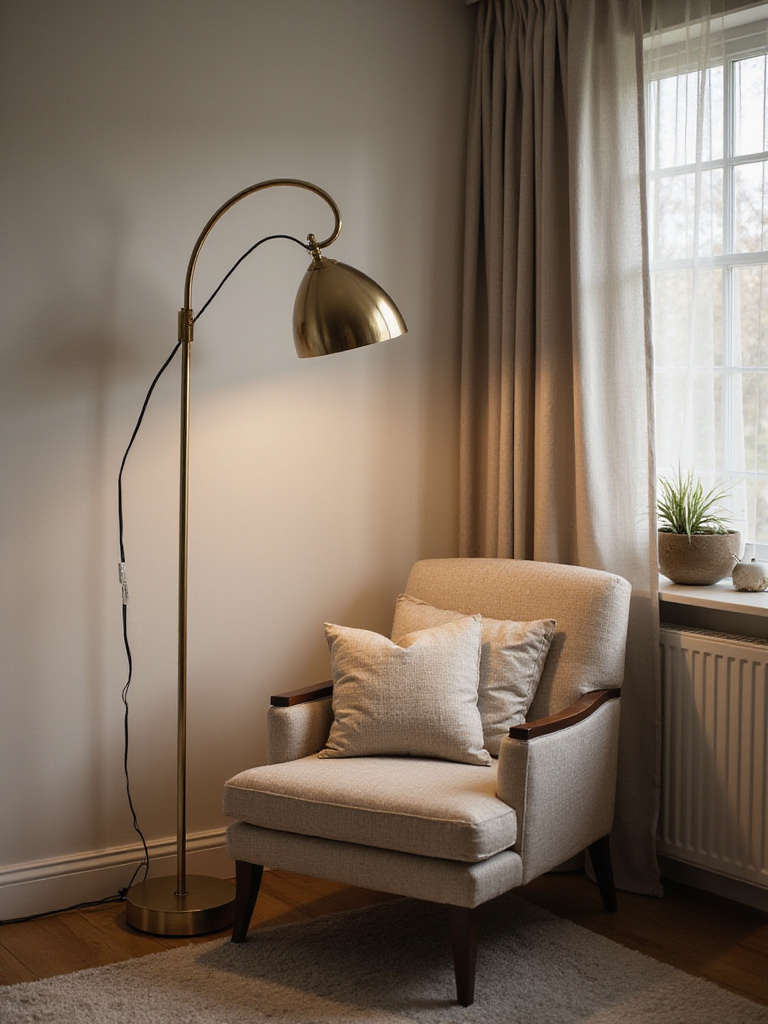
The transformative power of a well-chosen statement lamp extends beyond its immediate visual impact. An oversized arc floor lamp curving over a reading chair can transform an empty corner into a distinct, inviting zone while adding architectural interest that draws the eye upward. The interplay between form and function becomes particularly important in bedrooms, where lighting needs vary dramatically from bright morning preparation to soft evening relaxation.
Key considerations for statement lamp selection:
- Scale assessment: Ensure the lamp’s proportions complement your room size and existing furniture
- Style integration: Choose pieces that either harmonize with or intentionally contrast your current decor
- Light quality: Consider bulb type, color temperature, and dimming capabilities for optimal functionality
- Placement strategy: Position lamps to serve both aesthetic and practical lighting needs
Houzz surveys consistently show that improved lighting ranks among the top three priorities for bedroom renovations, with decorative fixtures being a primary focus for homeowners seeking to enhance their space’s aesthetic appeal and functional versatility.
12. Expand Your Space with Strategic Mirror Placement
Mirrors serve as powerful design tools that can visually double your room’s perceived size while dramatically enhancing natural light distribution throughout your space. These reflective surfaces work as optical illusions, creating depth and openness that make even compact bedrooms feel more spacious and inviting. When positioned strategically—particularly opposite windows—mirrors can increase natural light levels by 30-40%, brightening dark corners and reducing dependence on artificial lighting during daylight hours.
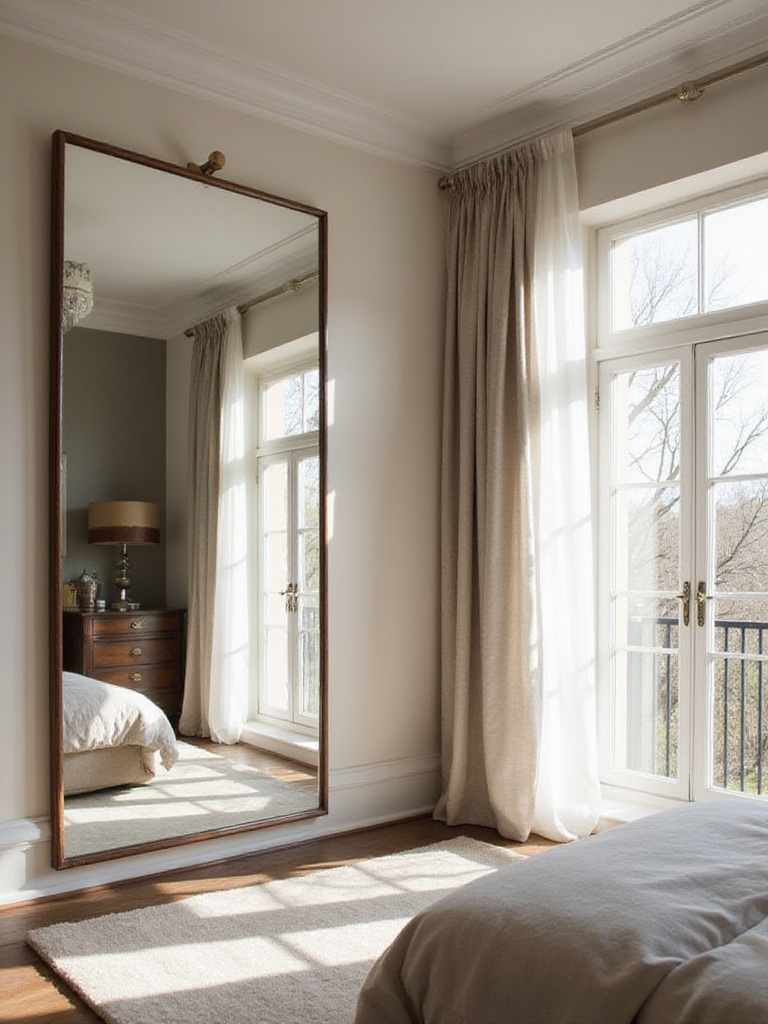
The psychological impact of increased light and perceived space cannot be understated. Brighter, more open-feeling rooms contribute to improved mood and reduced feelings of confinement, particularly important in bedrooms where we begin and end each day. One homeowner positioned a large floor-length mirror directly opposite their bedroom window, effectively creating a “second window” that reflected outdoor greenery while making their modest room feel twice as deep and significantly more connected to nature.
Strategic mirror placement techniques include:
- Light multiplication: Position mirrors to catch and reflect natural light from windows
- Space expansion: Place mirrors on walls perpendicular to windows to add perceived width
- Grouping strategies: Create gallery walls with multiple mirrors for artistic flair and broader light diffusion
- Furniture integration: Layer mirrors behind consoles or dressers to add visual depth
The American Society of Interior Designers reports that over 70% of design professionals list strategic mirror placement as a top-three technique for enhancing perceived spaciousness, confirming their effectiveness as essential tools in bedroom design.
13. Create Dual-Purpose Functionality with Compact Workspaces
Modern bedrooms increasingly serve multiple functions, making compact vanity or desk areas essential for maximizing space efficiency without compromising style. These dual-purpose pieces of bedroom furniture decor address the reality of contemporary living, where bedrooms often accommodate work, beauty routines, and personal care activities. The key lies in selecting furniture that seamlessly transitions between functions while maintaining the room’s aesthetic coherence and promoting organization rather than clutter.
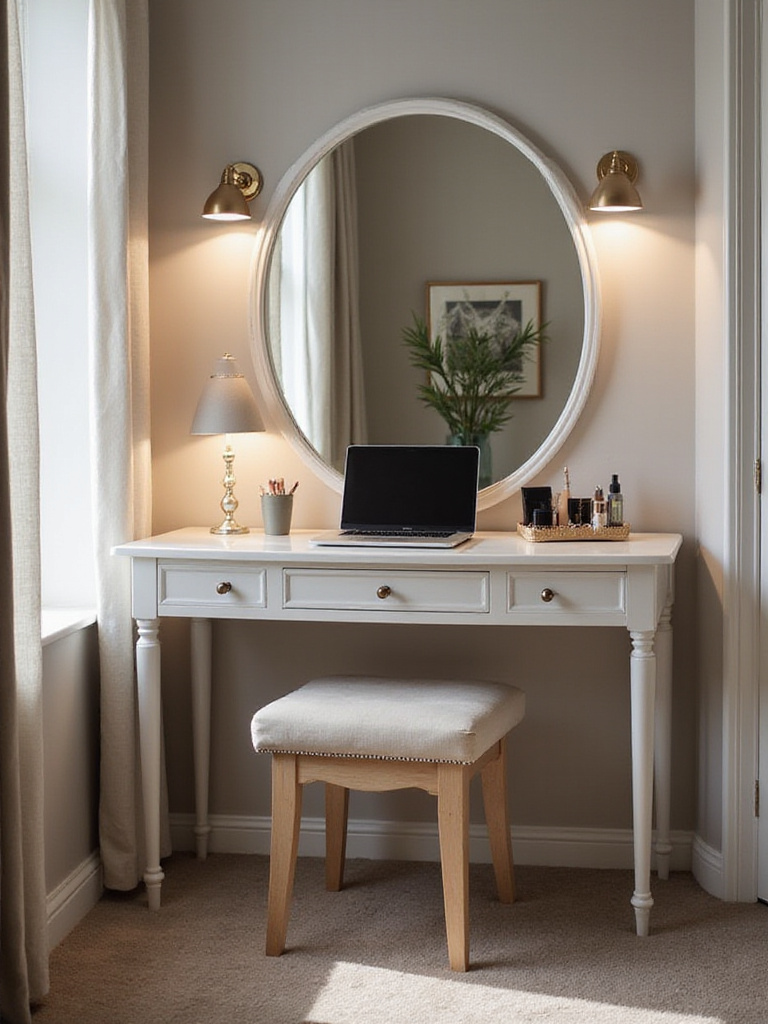
Multi-functional furniture has become increasingly sophisticated, with many pieces incorporating technology integration like built-in USB ports, wireless charging surfaces, and discrete cable management systems. One apartment dweller transformed a wall-mounted floating desk into both a morning vanity station and an efficient workspace for remote work, eliminating the need for separate furniture while maintaining the room’s clean, uncluttered aesthetic.
Essential elements for dual-purpose workspace success:
- Space optimization: Choose shallow-depth pieces (14-20 inches) to minimize footprint impact
- Storage integration: Look for built-in drawers, flip-top compartments, or wall-mounted organizers
- Lighting coordination: Incorporate task lighting suitable for both beauty routines and computer work
- Technology planning: Ensure adequate power access and cable management for devices
Houzz research indicates that 45% of homeowners now prioritize multi-functional furniture in bedroom renovations—a significant increase reflecting the growing need for adaptable living solutions in our increasingly space-conscious and flexible lifestyles.
14. Ground Your Design with Properly Sized Area Rugs
An appropriately sized area rug serves as the foundation that visually anchors your furniture arrangement while adding warmth, texture, and sound absorption to your bedroom environment. This essential piece of bedroom furniture decor defines your sleeping zone and creates cohesion among disparate furniture pieces, preventing your room from feeling disjointed or incomplete. The Carpet and Rug Institute notes that area rugs can reduce ambient noise levels by 20-30 decibels on hard flooring, significantly improving acoustics and contributing to a quieter, more peaceful sleep environment.
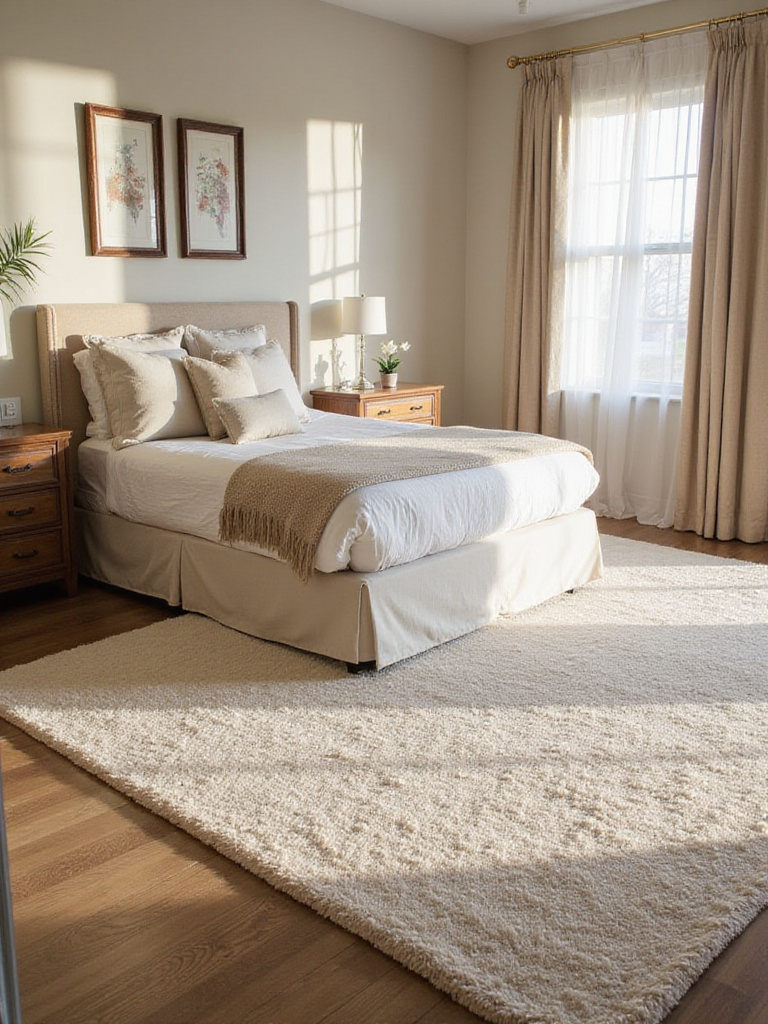
The most common decorating mistake involves selecting rugs that are too small, which makes rooms feel fragmented and unfinished. Proper sizing typically requires rugs that extend at least 18-24 inches beyond the sides and foot of your bed, ensuring that major furniture pieces are either fully on the rug or have their front legs anchored on its surface. This creates a unified composition that feels intentional and professionally designed.
Effective rug sizing guidelines include:
- Queen bed arrangements: Choose 8×10 or 9×12 rugs for adequate coverage and visual balance
- King bed layouts: Opt for 9×12 or larger rugs to properly anchor the expanded furniture footprint
- Placement strategies: Position rugs so the bed and nightstands are unified within the defined space
- Traffic flow consideration: Ensure rug edges don’t create tripping hazards or interfere with door swings
Interior designers consistently emphasize that a properly sized rug can transform a collection of furniture into a cohesive, sophisticated arrangement that feels both luxurious and thoughtfully planned.
15. Control Light and Privacy with Layered Window Treatments
Window treatments serve triple duty in bedrooms, controlling natural light exposure, ensuring privacy, and adding significant texture and style to your overall design scheme. These essential elements become particularly crucial for sleep quality, as sleep experts emphasize that maintaining darkness (ideally 0 lux) is critical for optimal melatonin production and circadian rhythm regulation. The U.S. Department of Energy notes that well-chosen window coverings can reduce heat loss by up to 25% during winter and heat gain by up to 33% during summer, contributing to both comfort and energy efficiency.
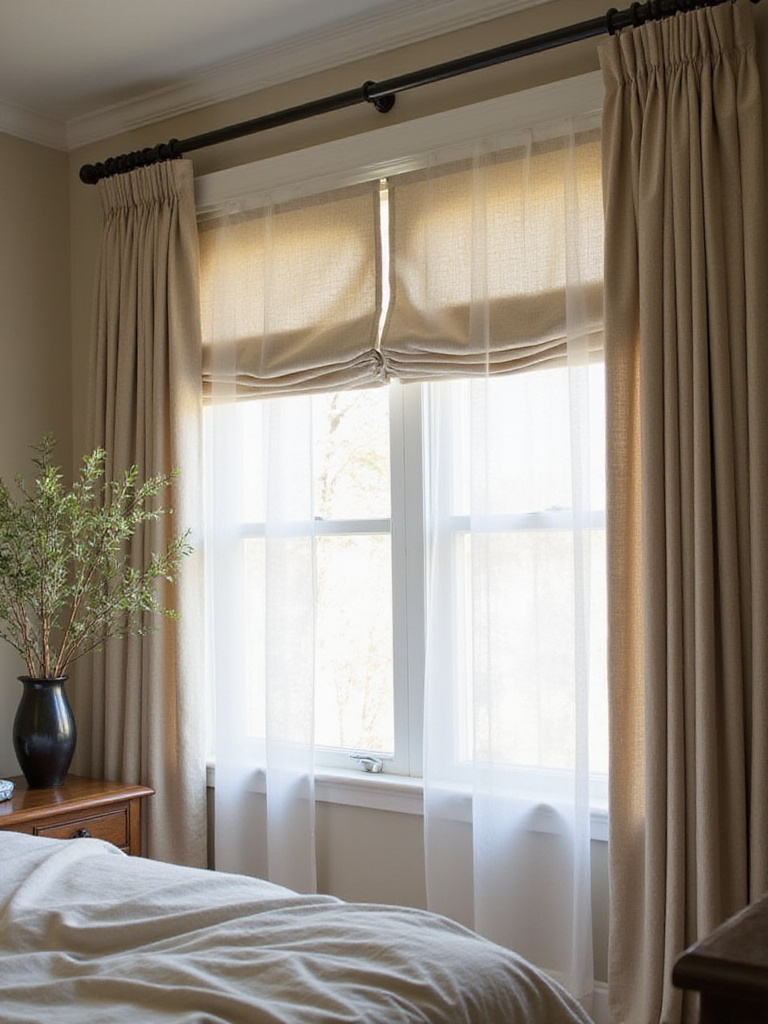
The sophistication of modern window treatment solutions allows for precise light control throughout the day. Layering systems—such as blackout shades beneath decorative panels—provide the flexibility to achieve complete darkness for sleep while maintaining soft, filtered light for daytime activities. One urban apartment dweller installed motorized blackout shades behind custom linen drapes, achieving perfect darkness despite streetlights while maintaining privacy and elegant daytime aesthetics.
Strategic window treatment selection involves:
- Function prioritization: Determine primary needs (blackout, light filtering, privacy, insulation)
- Measurement precision: Take accurate inside and outside mount measurements at multiple points
- Layering opportunities: Consider combining different treatment types for maximum versatility
- Installation optimization: Mount hardware high and wide to create illusions of larger windows and taller ceilings
The ability to control your bedroom’s light environment directly impacts your sleep quality, mood regulation, and overall comfort—making window treatments an investment in both style and well-being.
16. Express Your Personality Through Curated Wall Art
Wall art transforms your bedroom from a generic sleeping space into a deeply personal sanctuary that reflects your unique story, passions, and aesthetic sensibilities. This aspect of bedroom furniture decor offers the most direct opportunity to infuse your personality into the space, creating visual focal points that inspire and comfort you daily. The National Endowment for the Arts reports that 73% of adults believe art adds beauty to life, while 69% feel it helps them understand themselves better—highlighting art’s profound psychological impact in our most intimate spaces.
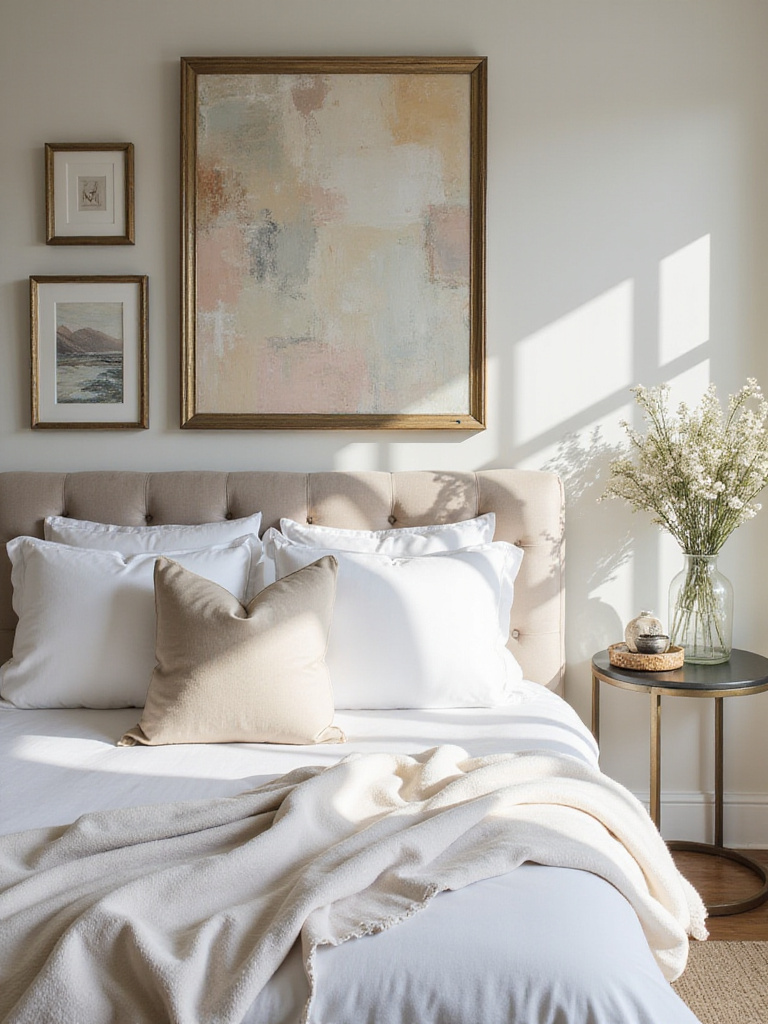
The curation process extends beyond simply filling wall space; it’s about creating visual narratives that resonate with your experiences and aspirations. A minimalist bedroom might feature a single large-scale abstract painting that establishes tranquility, while a more eclectic space might showcase a carefully arranged gallery wall mixing photography, textiles, and meaningful mementos. The key lies in selecting pieces that evoke emotional responses and collectively tell your personal story.
Effective art curation strategies include:
- Narrative development: Identify themes, color palettes, and styles that reflect your personality and desired mood
- Scale planning: Use paper templates or painter’s tape to test arrangements before committing to placement
- Source diversification: Explore local artists, online galleries, vintage finds, and personal photography for unique pieces
- Personal integration: Include meaningful items like framed letters, children’s artwork, or travel mementos alongside traditional art
The goal is creating a visual environment that continuously reinforces your sense of identity and belonging within your most private retreat.
17. Bring Natural Vitality with Strategic Plant Placement
Living plants introduce organic beauty and measurable health benefits to your bedroom environment, connecting your indoor space to the natural world while improving air quality and reducing stress levels. Biophilic design principles emphasize how integrating natural elements like plants can significantly enhance well-being, creativity, and overall life satisfaction. Research published in the Journal of Environmental Psychology demonstrates that people in plant-filled rooms report feeling 15% less stressed and more content than those in spaces without greenery.
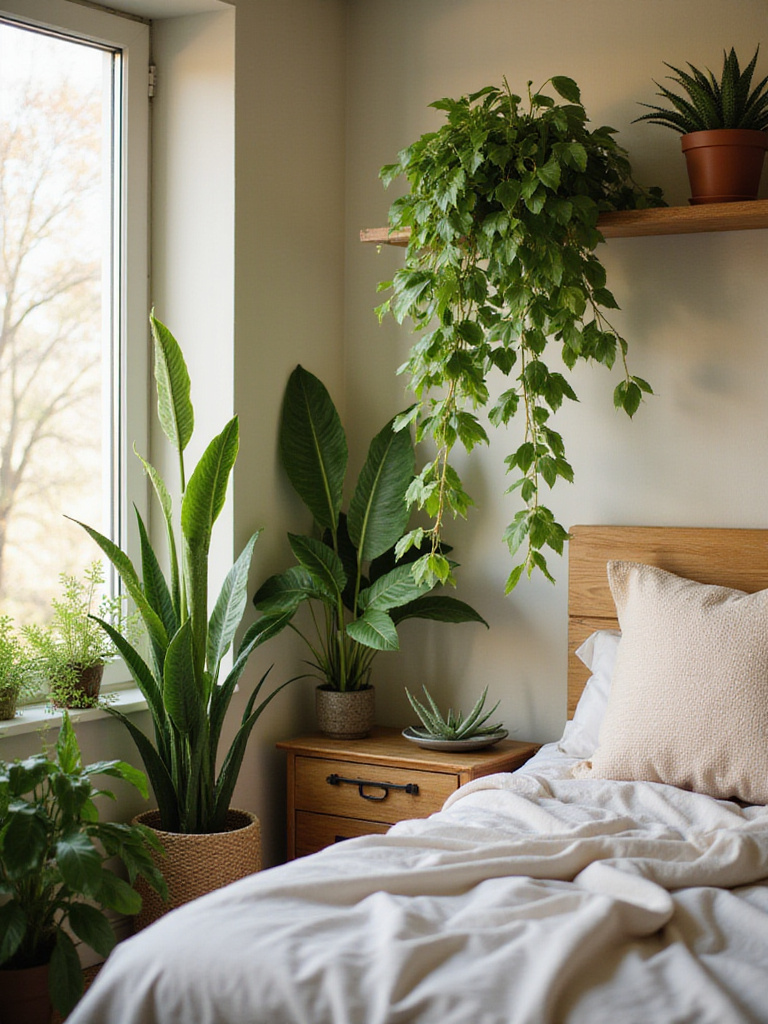
The air-purifying capabilities of specific houseplants extend beyond mere aesthetics. Snake plants, pothos, and spider plants can reduce concentrations of common indoor toxins like formaldehyde and benzene by 20-30% within 24 hours, contributing to cleaner air for better sleep quality. One urban apartment owner transformed their sterile bedroom by adding a tall sansevieria in a corner, trailing pothos on wall shelves, and a small aloe vera on the nightstand—immediately softening hard lines while adding warmth and vitality to the compact space.
Plant integration strategies for bedrooms include:
- Low-maintenance selection: Choose resilient species like snake plants, ZZ plants, or pothos that thrive in typical bedroom conditions
- Vertical utilization: Use hanging planters or tall plants to add greenery without consuming floor space
- Container coordination: Select pots and stands that complement your existing decor style
- Care planning: Understand watering, light, and humidity requirements to ensure long-term plant health
The presence of thriving plants creates a sense of nurturing and growth that enhances your bedroom’s role as a restorative sanctuary.
18. Curate Sophisticated Surface Arrangements
Thoughtful styling of surfaces like nightstands, dressers, and vanities transforms functional storage areas into curated vignettes that reflect your personality while maintaining organization. This attention to detail in your bedroom furniture decor elevates the overall sophistication of your space while making daily routines more pleasant and efficient. The University of Michigan research indicates that people living in organized, aesthetically pleasing environments report 20% lower daily stress levels compared to those in cluttered spaces.
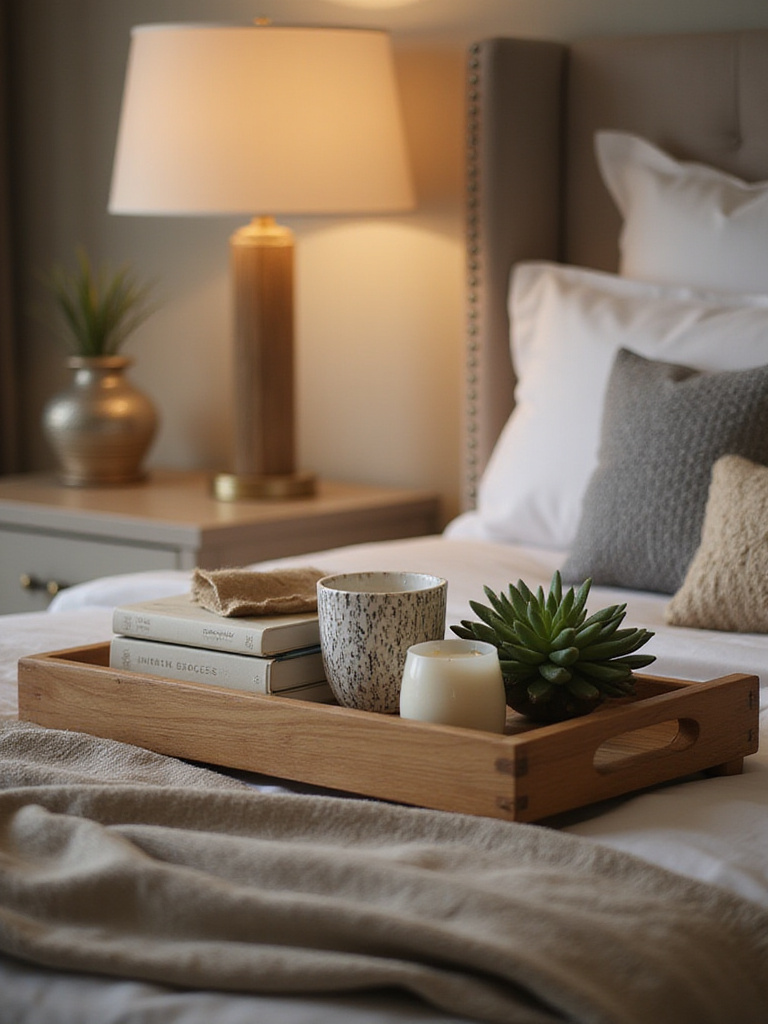
The art of surface styling follows design principles that create visual harmony and functional accessibility. The “Rule of Three” suggests grouping objects in odd numbers for natural visual appeal, while varying heights and textures creates dynamic interest. A bedside table might feature a small marble tray containing essential items, paired with a table lamp and a single fresh flower—creating an organized, beautiful, and functional bedside sanctuary.
Effective surface styling principles include:
- Tray utilization: Use decorative trays to contain and organize small items while creating defined zones
- Height variation: Arrange objects in triangular compositions with varied elevations for visual interest
- Texture mixing: Combine different materials (metal, wood, ceramic, glass) for tactile and visual richness
- Personal touches: Include meaningful objects that reflect your interests and experiences
The goal is creating arrangements that feel both intentional and effortless, contributing to your bedroom’s overall sense of calm sophistication.
19. Prioritize Physical Comfort in Every Furniture Choice
Comfort should guide every furniture selection in your bedroom, as this space serves as your primary retreat for rest, relaxation, and restoration. Ergonomic considerations become particularly crucial for pieces like mattresses, pillows, and seating, where proper support directly impacts your physical well-being and sleep quality. The Better Sleep Council reports that 70% of Americans believe their mattress directly impacts sleep quality, while 65% feel it affects their next-day mood—underscoring the critical importance of comfort-focused choices.
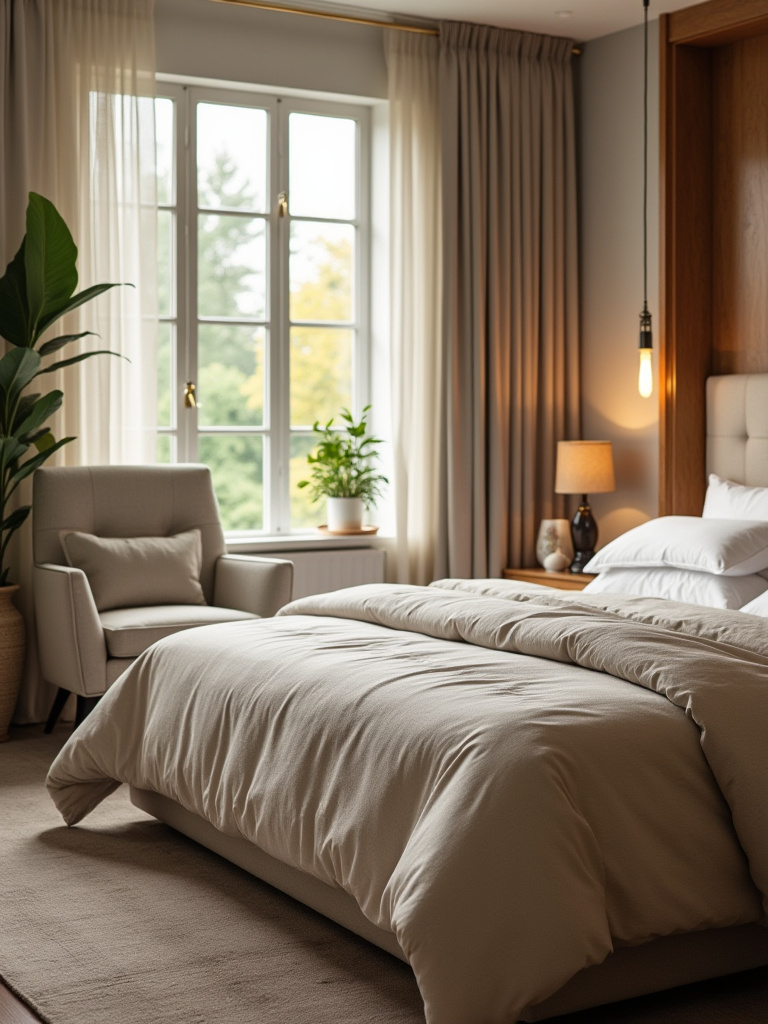
The investment in ergonomic bedroom furniture pays dividends in improved health outcomes and daily energy levels. Proper spinal alignment during sleep, supported by quality mattresses and pillows tailored to your sleeping position, can reduce morning stiffness and improve sleep continuity. One couple experienced a 50% reduction in morning back pain within two months of upgrading to a hybrid mattress with targeted lumbar support and position-specific pillows.
Comfort optimization strategies include:
- Sleep foundation assessment: Choose mattresses and pillows based on your sleeping position, body weight, and any physical conditions
- Seating evaluation: Select chairs and benches that provide ergonomic support for reading and relaxation
- Workspace ergonomics: If including a desk area, invest in proper seating and surface heights to prevent strain
- Sensory comfort: Integrate soft textiles, appropriate lighting, and sound-dampening elements for multi-sensory comfort
The transformation extends beyond physical comfort to encompass the emotional security that comes from a truly supportive and nurturing environment.
20. Achieve Visual Harmony Through Scale and Proportion
Mastering scale and proportion ensures that every piece of furniture fits comfortably within your space while creating visual balance and functional efficiency. These fundamental design principles determine whether your bedroom feels spacious and harmonious or cramped and chaotic. The National Association of Home Builders reports that well-designed, functional spaces—which inherently rely on proper scale and proportion—rank among the top three features influencing buyer decisions, affecting over 60% of purchase choices.
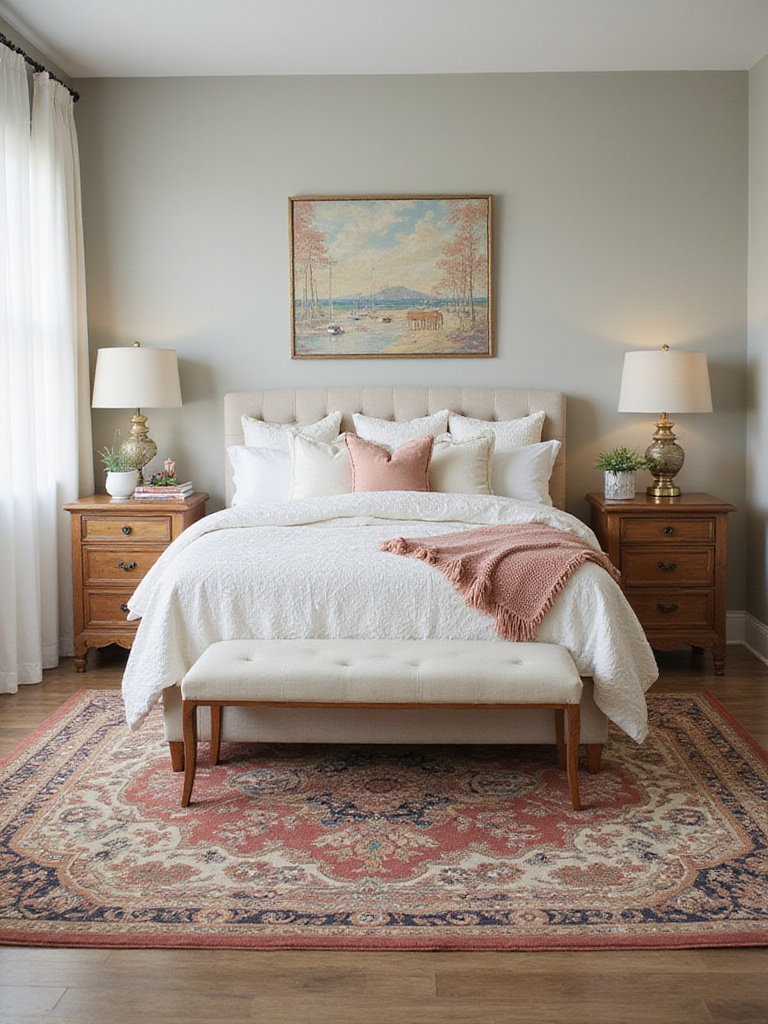
The relationship between furniture size and room dimensions directly impacts both aesthetics and functionality. Leaving adequate clearance around major pieces (ideally 30-36 inches for main pathways, 24 inches for secondary routes) ensures comfortable movement while preventing the room from feeling cluttered. One small apartment owner replaced a king bed with a queen size and added wall-mounted nightstands, immediately increasing usable floor space by 25% while dramatically improving the room’s perceived openness.
Essential scale and proportion guidelines include:
- Comprehensive measurement: Document room dimensions, furniture sizes, and clearance requirements before making purchases
- Layout experimentation: Use graph paper or digital tools to test different arrangements before committing
- Visual weight distribution: Balance large pieces throughout the room to avoid clustering and create even visual flow
- Negative space appreciation: Remember that empty space around furniture is as important as the pieces themselves
The artisan collective that creates these design principles has perfected techniques passed down through generations of furniture makers and interior designers, resulting in spaces that feel both professionally designed and deeply personal.
Conclusion
Creating your dream bedroom sanctuary is an intimate journey of thoughtful choices that extend far beyond surface aesthetics. Each element of bedroom furniture decor we’ve explored—from the foundational anchor of your bed frame to the subtle sophistication of curated surface arrangements—works together to create a space that nurtures your well-being while reflecting your unique personality. The true power lies not in expensive purchases, but in understanding how design principles like scale, proportion, and layered functionality can transform any bedroom into a deeply restorative retreat.
The 20 strategies we’ve covered provide a comprehensive roadmap for creating spaces that serve your daily rhythms while supporting your long-term health and happiness. Whether you’re working with a compact city apartment or a spacious master suite, these principles adapt to your specific needs and constraints. The key is approaching each decision with intention, considering how every piece contributes to both function and beauty in your most personal space.
Your bedroom transformation doesn’t require a complete overhaul—start with one or two elements that resonate most strongly with your current needs and gradually build your sanctuary over time. Perhaps begin with optimizing your lighting layers for better sleep, or introduce plants to bring natural vitality to your space. Remember that the most successful bedroom furniture decor tells your personal story while creating an environment that truly supports your well-being. Your perfect sanctuary awaits, ready to welcome you home each day to a space that reflects who you are and nurtures who you’re becoming.
